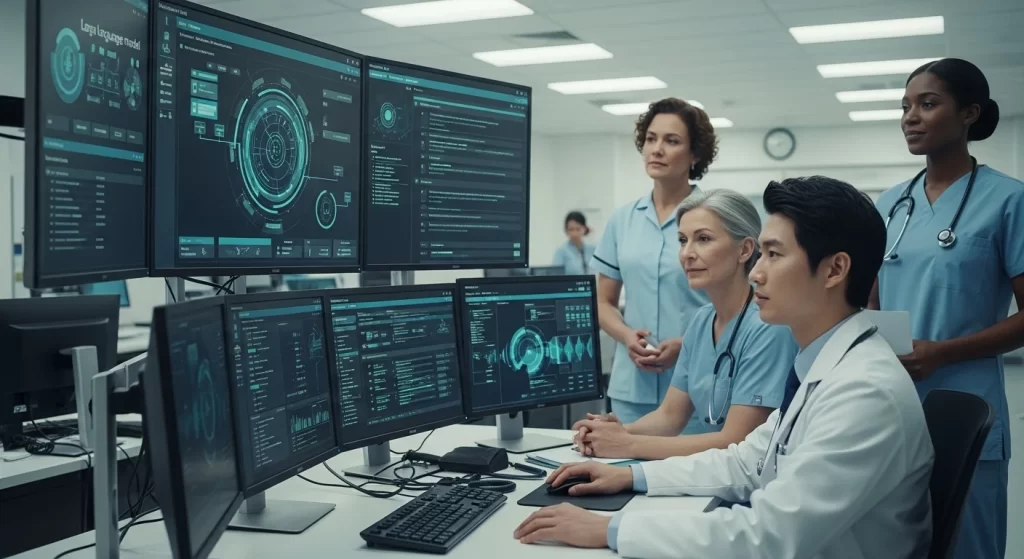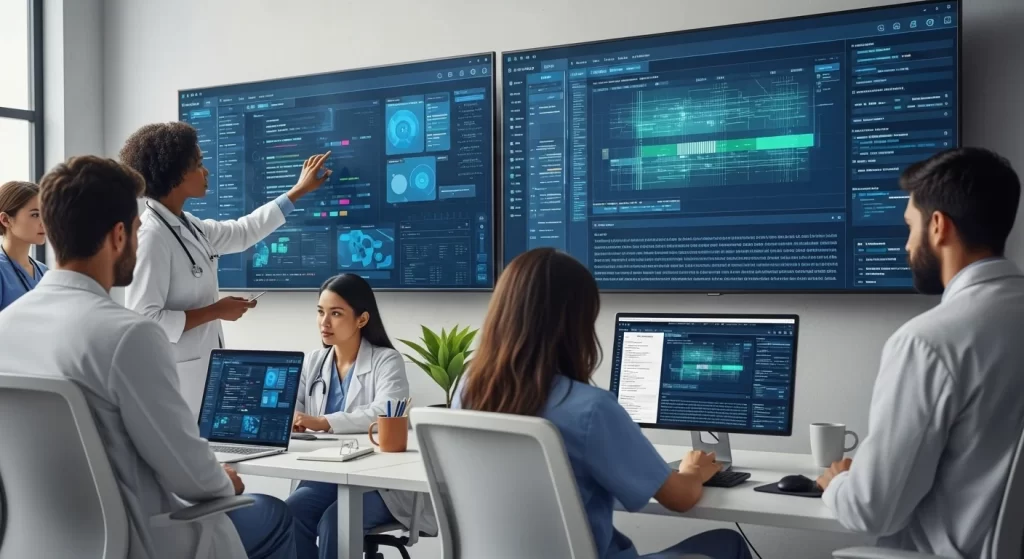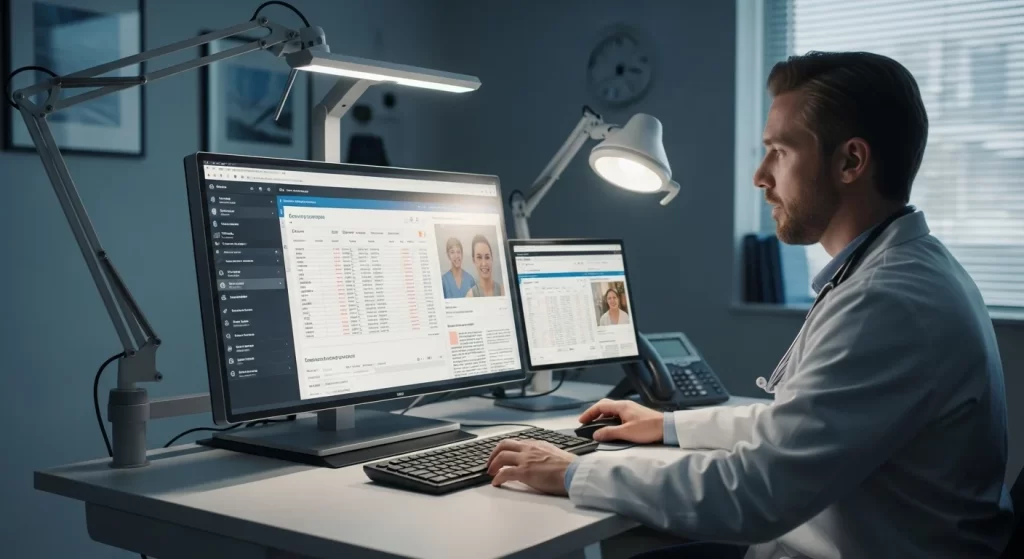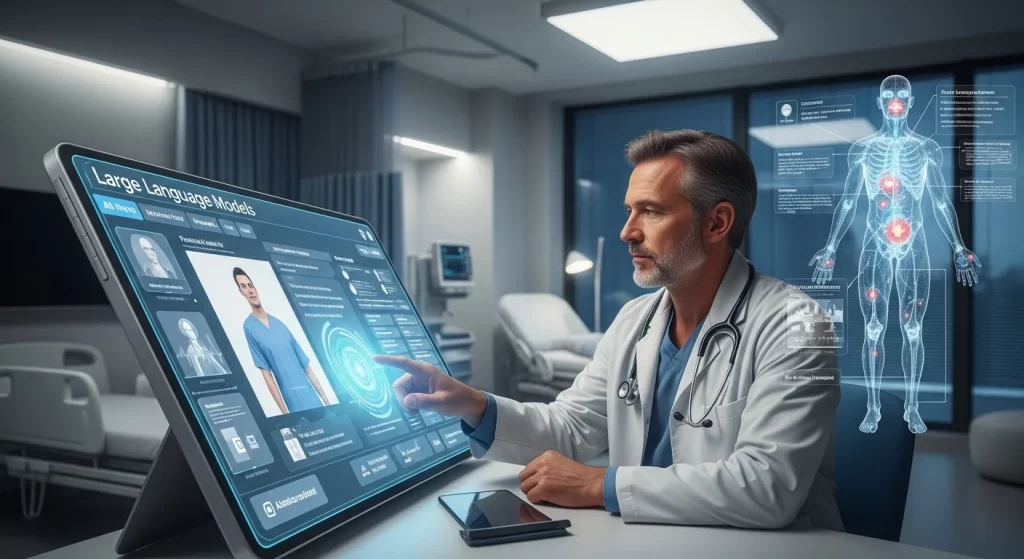Healthcare systems worldwide face a severe crisis of clinician burnout. Physician burnout rates remain high at 45% in early 2024, down from a 2021 peak of 56%, but still above pre-pandemic levels. Over 55% of nurses report burnout, with 23% considering leaving the profession. A primary cause is administrative burden: 62% of physicians cite charting and paperwork, spending nearly half their time on EHR input, and over 20% spend eight hours or more on EHRs outside of work. Nurses, too, dedicate up to one-third of their shifts to routine administrative duties. This systemic issue impacts patient safety, care quality, and financial health.

Burnout doubles the risk of medical errors and is linked to lower patient satisfaction. Financially, physician burnout costs the U.S. healthcare industry $4.6 billion annually due to lost productivity and turnover, with primary care physician turnover alone adding nearly $1 billion in excess patient costs. Large Language Models (LLMs) offer a glimmer of hope as “co-pilots” to augment human intelligence, automating tasks like patient message responses and clinical note generation, thereby addressing this crisis. The following sections will detail these burdens, explore the use of LLM in healthcare, and quantify their benefits, concluding with secure and ethical implementation strategies.
SPsoft is your expert guide, offering custom LLM development, end-to-end secure adoption, and seamless integration. Our human-centered design ensures LLM solutions enhance the lives of clinicians and patients!
The Unseen Epidemic: The Toll of Administrative Overload on Clinicians
The crisis of clinician burnout is a direct consequence of overwhelming administrative burdens, which erode well-being and negatively impact patient care.
Drowning in Documentation: The Time Drain
A significant portion of a clinician’s day is consumed by documentation, a task made more burdensome by electronic systems.
The Electronic Health Record (EHR) Paradox
Electronic Health Record (EHR) systems, while intended to streamline information management, have inadvertently become a major source of frustration and time drain for clinicians. Common complaints from physicians regarding EHR systems include their inherent complexity, time-consuming data entry processes, and the pervasive issue of “alert fatigue.” This digital burden pulls their focus away from direct patient interaction, leading to reduced productivity and increased dissatisfaction.
Quantifying this time drain reveals a stark reality. In 2023, physicians reported spending an average of 7.9 hours per week on administrative tasks, with 20.9% spending over eight hours on the EHR outside of regular work hours (“pajama time”). Physicians spend as much as 44.9% of their time on EHR input alone, leaving only 66.5% for direct patient care activities. Nurses, too, dedicate up to one-third of their shifts to routine and repetitive administrative tasks. The extensive time spent on Electronic Health Records (EHRs) highlights a critical inefficiency that contributes to clinician burnout. Legacy EHR systems, with their outdated technology and limited interoperability, further exacerbate these challenges, hindering the adoption of modern tools.
Table 1. Physician Time Allocation (Average Hours Per Week)
Activity | Average Hours/Week | Percentage of Time (Excluding Personal) |
|---|---|---|
| Direct Patient Care | 27.3 | 66.5% |
| EHR Input Alone | – | 20.7% |
| Administrative Tasks | 7.9 | 7.7% |
| Indirect Patient Care | 14.1 | – |
| Other Activities | – | 5.0% |
| Total Workweek | 59.0 | – |
Navigating the Information Deluge
Beyond direct data entry, clinicians face a significant challenge in accessing and synthesizing relevant information from a vast array of data. Patient records are often fragmented across various systems, and the volume of new medical literature and research papers is constantly expanding, making it difficult for clinicians to retrieve and process critical information quickly. This information overload has serious consequences, potentially leading to missed diagnoses, delayed treatments, and a general feeling of being overwhelmed. The ability to rapidly extract key findings, summarize research papers, or identify trends from vast biomedical literature is a critical unmet need for both clinicians and researchers.
The Human Cost: Impact on Well-being and Patient Connection
The administrative burden and information overload do not merely impact efficiency; they exact a profound human cost on clinicians’ well-being and their ability to connect with patients.
Rising Burnout Rates: A Crisis Point
As previously established, clinician burnout is a crisis that continues to plague the healthcare industry. Recent statistics paint a concerning picture. For physicians, the 2024 Medscape report indicates an overall burnout rate of 49%, with certain specialties experiencing even higher rates, including Emergency Medicine (63%) and OB-GYN (53%). A notable gender disparity also exists, with 56% of female physicians reporting burnout compared to 44% of male physicians in 2024. For nurses, the situation is equally critical, with over 55% reporting burnout. These statistics underscore that burnout is a complex, multifaceted issue, extending beyond individual resilience to encompass systemic factors such as unmanageable workloads and a lack of responsive leadership.
Table 2. Clinician Burnout Statistics for 2024
Profession/Specialty | Burnout Rate | Primary Causes Cited |
|---|---|---|
| Physicians (Overall) | 49% | Administrative tasks (62%), Too many work hours (41%), Lack of respect (40%) |
| Emergency Medicine Physicians | 63% | – |
| OB-GYN Physicians | 53% | – |
| Nurses (Overall) | >55% | Dissatisfaction with salary (63%), Lack of responsive leadership (60%), Unmanageable workloads (54%) |
| Female Physicians | 56% | – |
| Male Physicians | 44% | – |
Eroding the Art of Medicine
The relentless administrative burden fundamentally erodes the “art of medicine”—the empathetic, human-centered connection between clinician and patient. When clinicians are forced to spend excessive time on documentation and administrative tasks, their face-to-face time with patients is significantly reduced.
This diminished interaction directly impacts patient satisfaction and can weaken the crucial physician-patient relationship. Patients often notice this shift, with studies showing that nearly half (47%) reported their doctor spent less time looking at the computer during their visit when AI scribes were used, and 39% noted their doctor spent more time speaking directly with them. This loss of human connection undermines the very essence of healthcare, transforming what should be a deeply personal interaction into a transactional one.
Introducing the AI Co-Pilot: How Healthcare LLM Models Are Reshaping Clinical Workflows
The profound challenges posed by administrative overload and clinician burnout necessitate innovative solutions. Large Language Models (LLMs) are emerging as a transformative force, acting as intelligent “co-pilots” to redefine and optimize clinical workflows.

Understanding the AI Co-Pilot Concept for Healthcare
The integration of LLMs into healthcare is not a simple technological upgrade; it represents a fundamental shift in how advanced AI can augment human expertise.
More Than Just Chatbots: The Power of Contextual Understanding of LLM for Healthcare
Large Language Models are far more sophisticated than traditional AI or simple chatbots. Their power in healthcare stems from their ability to understand and generate complex, nuanced medical language. Unlike rule-based systems, LLMs are built upon advanced neural network architectures, notably the transformer architecture, and are trained on vast, diverse datasets. This extensive training allows them to grasp context, infer meaning, and produce coherent, contextually appropriate responses with a high degree of accuracy.
What makes LLMs particularly suited for healthcare data is their capacity to be trained or fine-tuned on large-scale biomedical corpora, including clinical notes, research papers, and patient records. This specialized training enables them to understand the intricate nuances of medical terminology, clinical jargon, and the complex relationships within patient data, leading to more accurate and reliable outputs in clinical contexts. This deep understanding of natural language, combined with their ability to generate human-like text, positions LLMs as powerful tools for automating documentation, assisting in clinical decision-making, and enhancing patient communication.
Augmentation, Not Automation
A crucial aspect of the AI co-pilot concept in healthcare is the philosophy of augmentation, not automation. This approach directly counters the “replacement” narrative that often accompanies discussions about AI in professional fields. Instead, LLMs are designed to support and enhance clinicians’ capabilities, allowing them to perform their roles more efficiently and effectively rather than taking over their core responsibilities.
The arguments for augmentation are strong and rooted in practical application. LLMs excel at processing vast amounts of data, identifying patterns, and generating text, which are tasks that often overwhelm human clinicians. By offloading these data-intensive, repetitive, and time-consuming administrative tasks, LLMs free up clinicians to focus on what humans do best: applying clinical judgment, exercising empathy, building patient relationships, and engaging in complex problem-solving that requires nuanced understanding and ethical consideration. For instance, while an LLM can draft a clinical note, the physician retains the ultimate responsibility for reviewing, editing, and signing it, ensuring accuracy and maintaining human oversight.
The boundaries of LLM capabilities in clinical judgment are clearly defined. LLMs are assistive tools; they do not possess consciousness, empathy, or the ability to make independent ethical decisions. They operate based on statistical patterns learned from their training data and do not inherently “understand” the world like humans do. While they can assist in differential diagnoses or suggest treatment recommendations, human oversight remains paramount to validate their outputs, interpret complex scenarios, and account for patient-specific factors that an algorithm might miss.
Ethical guidelines and expert opinions consistently emphasize the human-in-the-loop approach, ensuring that clinicians remain the ultimate decision-makers. This collaborative model, where AI’s efficiency is combined with human judgment, creativity, and empathy, is the cornerstone of successful large language model (LLM) integration in healthcare.
Key Missions for Your Healthcare LLM Co-Pilot
The practical applications of LLM in healthcare are diverse and directly target the pain points identified in current clinical workflows.

Intelligent Documentation & Ambient Scribing with LLM in Healthcare
One of the most immediate and impactful applications of LLM in healthcare is intelligent documentation, particularly through ambient AI solutions. These systems utilize LLMs to passively listen to and transcribe patient-physician conversations in real-time, then automatically generate drafts of clinical notes, including progress notes, history and physical (H&P) examinations, and discharge summaries. This technology aims to reverse the trend of “pajama time” by freeing doctors from the keyboard during patient encounters, allowing them to maintain eye contact and focus on the patient rather than the computer.
Studies have already demonstrated significant time savings and improved clinician satisfaction. For example, a 63-week evaluation at The Permanente Medical Group (TPMG) involving over 7,260 physicians and 2.5 million patient encounters found that generative AI scribes saved an estimated 15,791 hours of documentation time—equivalent to 1,794 eight-hour workdays. That led to statistically significant reductions in note-taking time, time spent per appointment, and “pajama time.” Clinicians overwhelmingly reported a positive effect on communication (84%) and improved overall work satisfaction (82%).
Rapid Information Synthesis & Pre-Visit Summaries
LLMs possess a remarkable ability to process and synthesize vast amounts of fragmented patient data, transforming it into concise, actionable summaries. This capability is particularly valuable for generating pre-visit summaries, allowing clinicians to quickly grasp a patient’s complex medical history before an encounter. LLMs can pull key information from disparate sources within patient records, including lab results, past diagnoses, medications, and clinical notes, to create a comprehensive yet digestible overview.
That has a significant impact on visit preparedness and efficiency. Clinicians can rapidly review a patient’s longitudinal health record, reducing cognitive burden and potential delays in diagnosis and treatment that arise from information overload. Studies exploring LLM-generated problem-based admission summaries for conditions like heart failure have shown that summary use maintains accuracy in answering clinical questions (88.0% with summaries vs. 86.4% without), and a high percentage of physicians (87.5%) reported that the summaries would save them time.
Smarter Clinical Decision Support
LLMs are poised to revolutionize clinical decision support (CDS) by providing intelligent assistance in complex diagnostic and treatment scenarios. These models can analyze patient symptoms, medical records, and vast repositories of medical literature to assist in generating differential diagnoses, recommending appropriate treatments, and identifying relevant clinical guidelines. For example, LLMs can integrate real-time, up-to-date medical information from databases such as UpToDate and StatPearls directly into their responses. They can also assist in prioritizing patients based on symptoms and vital signs, thereby reducing waiting times and improving care delivery.
However, the limitations of LLMs in CDS, as well as the absolute necessity of human oversight, are critical considerations. While LLMs can achieve high accuracy on standardized medical exams (e.g., GPT-4 achieving 87.6% on USMLE-style questions), performance metrics alone are insufficient for clinical deployment. LLMs primarily rely on statistical correlations rather than causal reasoning, making human verification essential to mitigate risks like “hallucinations.” Strategies like Retrieval-Augmented Generation (RAG) help ground LLM responses in factual, external data, enhancing accuracy and verifiability. Human-in-the-loop mechanisms are vital to ensure that clinicians maintain ultimate control, validate AI suggestions, and apply their nuanced judgment to patient-specific factors.
Streamlining Patient Communications & Follow-ups
LLMs offer a significant opportunity to enhance patient engagement and reduce clinician workload by streamlining patient communications and follow-ups. These models can draft personalized patient education materials, generate clear follow-up instructions, and respond to common patient queries, all tailored to individual patient data and preferences. This capability allows for a shift from generic, standardized information to dynamic, personalized learning experiences.
The benefits are multifaceted. For patients, it means receiving understandable medical information, leading to enhanced engagement, improved adherence to treatment plans, and better overall health outcomes. For clinicians, this translates into a significant reduction in workload, as it automates routine inquiries and streamlines drafting communications. A study found that LLM-generated draft responses to patient messages could reduce response times, with support staff experiencing an average time savings of 23 seconds. That allows clinicians to focus more on direct patient care and complex interactions, thereby fostering trust and enhancing the patient-physician relationship.
Accelerating Medical Research & Literature Review
The sheer volume of new medical literature and research findings presents a constant challenge for clinicians and researchers who strive to stay current and incorporate the latest evidence into their practice. LLMs are uniquely positioned to accelerate medical research and literature review by rapidly extracting key findings, summarizing vast numbers of research papers, and identifying emerging trends in biomedical literature.
LLMs can sift through millions of research papers, clinical trials, and patient records in a fraction of the time it would take human researchers to identify patterns and insights that would otherwise be impossible to detect. This capability streamlines systematic reviews, a labor-intensive process, by pre-filtering scientific records and reducing manual workload by 33% to 93% during title and abstract screening. For a medical research team, an LLM can draft reports based on clinical trial data, accelerating submissions and improving efficiency. By automating these time-consuming aspects of research, LLMs free up human experts to focus on critical analysis, experimental design, and the more profound implications of findings, thereby accelerating the pace of medical innovation and the development of new treatments.
Table 3. Key LLM Applications in Healthcare
Application Area | Description | Example/Benefit |
|---|---|---|
| Intelligent Documentation | Automating clinical note generation and ambient scribing. | AI scribes saved 15,791 hours of documentation time for over 7,260 physicians over 63 weeks. |
| Information Synthesis | Creating concise pre-visit summaries from fragmented patient records. | Improves clinician preparedness and reduces cognitive burden. |
| Clinical Decision Support | Assisting with differential diagnoses, treatment recommendations, and guideline adherence. | LLMs can integrate real-time medical information from databases like UpToDate. |
| Patient Communication | Drafting personalized patient education materials and responding to common queries. | LLM-generated draft responses reduced patient message response times by 23 seconds for support staff. |
| Medical Research | Rapidly extracting findings, summarizing papers, and identifying trends in literature. | Streamlines systematic reviews, reducing manual workload by 33-93%. |
| Operational Efficiency | Automating administrative tasks like scheduling, billing, and claims processing. | Reduced claim denials by 85% and achieved 60% faster claim submission in one case study. |
| Personalized Medicine | Tailoring care plans based on individual patient data (genetics, lifestyle). | Identifying optimal drug targets and predicting drug interactions. |
| Diagnostic Accuracy | Analyzing symptoms, medical history, and images to enhance diagnostic precision. | AI systems like AMIE have outperformed primary care physicians in diagnostic accuracy. |
Realizing the Vision: Tangible Benefits for Clinicians, Patients, and Organizations
The integration of LLM in healthcare is not merely a theoretical advancement; it translates into concrete, measurable benefits across the entire healthcare ecosystem, impacting clinicians, patients, and the operational efficiency of healthcare organizations.

Reclaiming Precious Time: The Ultimate Efficiency Gain from LLM in Healthcare
The most immediate and impactful benefit of LLM-powered solutions is the significant reclamation of time for clinicians, directly addressing a primary driver of burnout.
Hours Saved Per Day
Studies and early adoption programs are beginning to quantify the substantial time savings clinicians can achieve by leveraging LLM-powered tools. For instance, a follow-up analysis at The Permanente Medical Group (TPMG) revealed that generative AI scribes saved physicians an estimated 15,791 hours of documentation time over 63 weeks, equivalent to 1,794 eight-hour workdays. That translates to a statistically significant reduction in note-taking time, time spent per appointment, and the burdensome “pajama time.”
Another pilot study involving LLMs for drafting patient message responses in EHR systems showed a reduction in message response time of 13 seconds on average for all users, with support staff experiencing a more substantial saving of 23 seconds. The cumulative effect across thousands of patient encounters and hundreds of clinicians results in thousands of hours reclaimed annually.
Optimized Clinical Workflows
Beyond direct time savings, LLMs contribute to optimized clinical workflows by creating smoother and more integrated processes, from patient intake to discharge. This optimization stems from the LLMs’ ability to automate and streamline various administrative and information management tasks that traditionally act as bottlenecks. For example, LLMs can automate tasks such as appointment scheduling, medical data entry, and summarizing medical notes into structured EHR fields. They can also generate insurance coding summaries immediately after patient visits, improving claim turnaround times and reducing administrative overhead.
This end-to-end support reduces manual effort, minimizes errors, and ensures that critical information flows efficiently across the care continuum, leading to increased productivity and a more streamlined patient experience.
A Healthier Workforce: Boosting Well-being and Engagement
The direct impact of LLM adoption on clinician well-being and engagement is a pivotal benefit, addressing the core issue of burnout.
Significant Reduction in Burnout
By alleviating the heavy administrative burden, LLMs directly contribute to a significant reduction in physician and nurse burnout. The time saved on documentation and routine tasks translates into reduced “pajama time” and a lighter cognitive load during the workday. When clinicians spend less time on paperwork, they experience less emotional exhaustion and depersonalization, which are key characteristics of burnout. The TPMG study on AI scribes, for instance, found that 82% of physicians reported improved overall work satisfaction. This improvement in job satisfaction is a direct indicator of reduced burnout, fostering a healthier and more engaged workforce.
Renewed Focus on Patient Relationships
One of the most profound impacts of reducing administrative burden through LLM adoption is the ability for clinicians to reclaim precious face-to-face time with their patients. When freed from constant keyboard interaction and data entry, physicians and nurses can dedicate more attention to direct patient engagement, listening actively, and building stronger therapeutic relationships. Patients, for their part, notice the difference; studies show that nearly half (47%) felt their doctor spent less time looking at the computer, and 39% noted more direct conversation, leading to 56% reporting a positive impact on the quality of their visit. That fosters greater patient satisfaction, enhances trust, and can lead to better adherence to treatment plans, ultimately improving health outcomes.
Elevating Care Quality and Outcomes
The benefits of LLM in healthcare extend directly to the quality of care delivered and, consequently, to patient outcomes.
Enhanced Diagnostic Precision
LLMs contribute to enhanced diagnostic precision by providing clinicians with quicker access to comprehensive and synthesized patient data, as well as vast medical literature. These models can process and interpret complex medical texts, identifying subtle patterns and extracting critical information that might otherwise be overlooked. By synthesizing a patient’s entire medical history, LLMs can present a holistic view that aids in formulating a more accurate differential diagnosis. This rapid information retrieval and synthesis capability enhances diagnostic accuracy and accelerates the diagnostic process, which is crucial in time-sensitive clinical environments.
More Personalized and Proactive Treatment Plans
LLMs are instrumental in facilitating the development of more personalized and proactive treatment plans, moving healthcare towards a truly patient-centric model. By analyzing individual patient data—including genetic information, medical history, lifestyle factors, and medication responses—LLMs can identify potential risks, suggest preventive strategies, and tailor care plans to meet the unique needs of each patient. For example, LLMs can assist in identifying optimal drug targets, predicting drug interactions, and recommending therapies that might typically be overlooked, leading to more effective and safer treatments. This proactive approach allows healthcare providers to intervene earlier, potentially preventing complications and improving long-term health outcomes.
Operational Excellence for Healthcare Systems
Beyond direct clinical benefits, LLMs offer significant advantages for the operational efficiency and financial health of healthcare systems.
Cost Savings and Resource Optimization
The widespread adoption of LLM in healthcare promises substantial cost savings and optimized resource allocation for healthcare organizations. The estimated annual cost of physician burnout in the U.S. healthcare industry is $4.6 billion, mainly due to lost productivity and clinician turnover. By directly addressing burnout and improving efficiency, LLMs can mitigate these costs. For instance, reducing physician burnout by just 20% in a hospital with 500 physicians could result in annual savings of over $2 million in staffing costs.
The elimination of manual paperwork and automation of documentation, billing, and patient inquiries reduce administrative overhead, freeing up staff for higher-value tasks. LLMs can streamline processes such as insurance claims processing, reducing denials by automating validation and ensuring compliance with coding standards, which leads to faster reimbursements and improved revenue cycle efficiency. As the cost of developing and deploying LLMs decreases, these sophisticated capabilities become accessible even to smaller clinics and independent practitioners, making LLMs a financially prudent investment.
Improved Data Quality and Compliance Readiness
LLMs play a crucial role in improving data quality within healthcare systems and bolstering compliance readiness. Automated documentation and data extraction, powered by LLMs, significantly reduce human error and inconsistencies inherent in manual data entry. By transcribing physician-patient conversations and summarizing medical notes into structured EHR fields, LLMs ensure that patient information is accurate, up-to-date, and consistently formatted.
This automated process can detect inconsistencies and errors in medical records, ensuring the integrity of patient data. High-quality, standardized data is essential not only for effective patient care but also for regulatory compliance. LLMs can monitor and ensure adherence to regulatory standards, such as HIPAA and GDPR, by automating compliance reporting and identifying potential compliance issues in vast amounts of text. They can also assist in data anonymization, protecting sensitive patient information while still allowing for valuable data analysis and research.
Partnering for Progress: Secure and Ethical LLM Implementation in Healthcare with SPsoft
Navigating the complexities of LLM adoption in healthcare requires specialized expertise and a strategic partner. SPsoft offers a comprehensive approach designed to deliver secure, compliant, and highly effective LLM solutions.

Custom LLM Development & Fine-tuning for Specific Healthcare Needs
Off-the-shelf, general-purpose LLM models are often insufficient for the highly specialized and precision-demanding environment of healthcare. While foundational models like GPT-4 are trained on vast and diverse text data, they lack the specific medical knowledge, contextual understanding, and nuanced terminology required for accurate clinical applications. Relying on general LLMs without domain-specific adaptation can lead to misdiagnosis or inaccurate recommendations.
Custom LLM development and fine-tuning are crucial for overcoming these limitations. Fine-tuning involves adjusting the parameters of a pre-trained model using a smaller, highly specialized dataset. For healthcare, this process entails:
- Using high-quality, clinically relevant domain-specific data (patient records, clinical notes, biomedical literature).
- Integrating medical ontologies (like ICD codes or SNOMED CT) to guide responses.
- Ensuring annotation accuracy by medical experts.
- Implementing continuous learning and updates as medical knowledge evolves.
SPsoft’s approach focuses on developing custom LLM models tailored to specific healthcare needs, ensuring they possess the precision and contextual understanding demanded by clinical environments. This bespoke development ensures the LLM is not just a general AI tool but a proper healthcare LLM optimized for tasks ranging from diagnosing rare diseases to predicting potential health issues.
End-to-End Secure & Compliant Implementation
Implementing LLM in healthcare is a multi-stage process that demands rigorous attention to security and compliance at every phase. SPsoft provides end-to-end, secure, and compliant implementation guided by a structured roadmap that ensures patient safety and regulatory adherence.
This comprehensive process involves distinct phases, each requiring specialized expertise:
- Planning: Defining project scope, aligning with clinical needs, planning bias mitigation, establishing data privacy, analyzing regulatory requirements (HIPAA, GDPR, FDA), and assessing IT infrastructure. Key roles include clinical informaticists, AI ethicists, and cybersecurity specialists.
- Development: Curating representative datasets, fine-tuning LLMs for accuracy and interpretability, ensuring data quality and privacy, and designing for patient-centricity and clinician involvement. Data scientists, LLM developers, clinical informaticists, AI ethicists, and cybersecurity specialists are crucial.
- Validation: Rigorously testing performance, clinical utility, and adherence to ethical/safety standards in controlled environments, including assessing patient outcomes, user experience, and workflow integration. Clinical informaticists, healthcare providers, AI ethicists, cybersecurity specialists, and biostatisticians are essential.
- Deployment: Integrating the validated LLM into existing IT systems and workflows, ensuring seamless operation and continuous monitoring of patient outcomes and user experience. IT professionals, system administrators, clinical informaticists, cybersecurity specialists, and healthcare providers are key.
- Maintenance: Ensuring the deployed LLM adapts to evolving clinical requirements and regulatory landscapes through continuous monitoring, iterative improvements, and long-term impact analysis. That involves ongoing clinical collaboration, performance monitoring, and the development of scalable infrastructure.
This collaboration is crucial for aligning technical performance with operational demands and clinical relevance, thereby transforming validated systems into scalable tools that enhance decision support and lead to measurable patient outcomes.
Integrating AI into Your Existing Ecosystem
The seamless integration of LLM solutions into a healthcare organization’s existing IT ecosystem is paramount for successful adoption and realizing the full benefits. Healthcare environments are often characterized by complex, heterogeneous, and legacy systems, including Electronic Health Records (EHRs) that can be siloed and resistant to new technology. SPsoft employs sophisticated technical approaches to ensure smooth and secure data flow.
Key integration strategies include:
- APIs (Application Programming Interfaces): SPsoft utilizes modern, standardized APIs, particularly FHIR and HL7, for quick and safe data exchange between LLMs and EHRs, ensuring comprehensive compliance. Custom APIs can also connect with proprietary or older systems.
- Secure Data Flow Management: Ensuring the security and privacy of patient data during integration is non-negotiable. SPsoft implements robust measures such as end-to-end encryption (protecting data both at rest and in transit), de-identification techniques (applying anonymization and pseudonymization to sensitive data before LLMs process it), role-based access control (RBAC) (limiting access to PHI based on user roles and authorization levels), and audit trails (maintaining comprehensive records of all data access and processing activities for compliance and security monitoring). SPsoft also encourages the use of LLMs hosted within the organization’s secure environment or private cloud instances to prevent data exposure to external parties.
By meticulously managing data flow and leveraging these technical architectures, SPsoft ensures that LLM solutions are not just bolted on but seamlessly integrated, enhancing workflows and ensuring continuous, uninterrupted patient care while adhering to the highest standards of data security and regulatory compliance.
Collaborative & Ethical Partnership
Successful adoption of AI in healthcare is not solely a technical endeavor; it is fundamentally a human one. SPsoft emphasizes a collaborative and ethical partnership approach, ensuring that AI solutions are human-centered and address the concerns of all stakeholders, particularly clinicians and patients.
“Human-centered AI design” in healthcare refers to the development of AI technologies that prioritize human needs, values, and capabilities at their core. This approach ensures that AI systems enhance human abilities and well-being rather than replacing or diminishing human roles. It involves designing AI that is accessible, usable, and beneficial to all segments of society while also addressing ethical, social, and cultural implications.
By fostering such a collaborative and ethical partnership, SPsoft ensures that LLM solutions are not just technologically advanced but also deeply integrated into the human-centric nature of healthcare, leading to greater trust, wider adoption, and, ultimately, better outcomes for all.
Final Thoughts
The challenges facing modern healthcare—from pervasive clinician burnout to the critical need for enhanced patient safety and operational efficiency—are immense. Large Language Models (LLMs) offer a truly transformative solution. These AI co-pilots augment human roles, empowering clinicians by reclaiming their time, reducing administrative burdens, and allowing them to refocus on direct patient care. LLM in healthcare can significantly cut documentation time, streamline workflows, and alleviate cognitive load, promising a healthier, more engaged workforce and measurable improvements in diagnostic precision, personalized treatment, and overall care quality. Operational efficiencies and cost savings further offer a sustainable path for healthcare systems.
Envision a future where clinicians are free to engage deeply with patients, supported by intelligent co-pilots handling documentation and information synthesis. It is the promise of LLM-augmented healthcare: a future where medical errors are minimized, treatment plans are precisely tailored, and administrative tasks are largely automated, allowing human empathy and judgment to flourish. This vision is an achievable reality driven by responsible innovation and strategic LLM implementation.
The journey towards increasing efficiency and reducing burnout with LLM in healthcare begins now. Partner with SPsoft to navigate this innovation, build trust, and shape a more sustainable and compassionate healthcare future!
FAQ
How do LLM models specifically improve clinical decision-making?
LLM models enhance clinical decision-making by rapidly processing and synthesizing vast amounts of medical information, including patient data, medical literature, and clinical guidelines. They can assist in generating differential diagnoses, suggesting treatment recommendations based on evidence, and identifying relevant clinical protocols. This capability provides clinicians with quick access to comprehensive insights, reducing cognitive burden and supporting more informed choices.
For example, LLMs can integrate real-time, up-to-date medical information from databases such as UpToDate and StatPearls directly into their responses. They can also assist in prioritizing patients based on symptoms and vital signs, thereby reducing waiting times and improving care delivery. However, human oversight remains crucial for validating these suggestions and applying nuanced clinical judgment.
Can LLM models accurately analyze complex medical data and patient histories?
Yes, LLM models can analyze complex medical data and patient histories with remarkable accuracy, exceptionally when trained or fine-tuned on domain-specific biomedical corpora. They excel at processing unstructured text from patient notes, lab reports, and fragmented records to identify patterns, extract key information, and create concise summaries. While general LLMs may struggle with the nuances and potential for “hallucination,” specialized or Retrieval-Augmented Generation (RAG) enhanced LLMs improve reliability by grounding responses in verified external knowledge. Human validation is always necessary for critical clinical applications.
What are real-world examples of successful LLM applications in healthcare?
Real-world examples of successful LLM applications in healthcare include:
– Ambient AI scribes: Systems like those piloted at Kaiser Permanente have saved thousands of hours of documentation time, allowing physicians to focus more on patient interaction.
– Automated patient message responses: Integrations with EHR systems, such as Microsoft and OpenAI’s ChatGPT-4 with Epic, streamline communication and reduce clinician workload.
– Pre-visit summaries: LLMs can synthesize fragmented patient records into concise summaries, improving clinician preparedness for appointments.
– Claim scrubbing and revenue cycle optimization: LLM-powered systems have reduced claim denials by 85% and accelerated claim submission by 60%.
– Personalized patient education: LLMs can draft tailored educational materials and follow-up instructions based on individual patient data.
– Medical research assistance: LLMs can rapidly summarize research papers and identify trends in vast biomedical literature, thereby significantly reducing the time required for manual review in systematic reviews.
– Diagnostic support: AI systems, such as AMIE (Articulate Medical Intelligence Explore), have outperformed primary care physicians in terms of diagnostic accuracy and communication quality across simulated cases.
How do healthcare organizations handle data privacy concerns when using LLM models?
Healthcare organizations address data privacy concerns by implementing robust security measures and adhering to regulations such as HIPAA and GDPR. Key strategies include:
1. End-to-end encryption: Protecting Protected Health Information (PHI) both at rest and in transit.
2. Strict access controls: Implementing role-based access control (RBAC) and multi-factor authentication to limit PHI access to authorized personnel.
3. De-identification techniques: Using anonymization, pseudonymization, and tokenization to remove or mask personal identifiers from data, especially for LLM training.
4. Private LLM deployments: Utilizing company-managed or on-premise LLMs instead of public APIs to ensure data remains within a secure environment.
5. Comprehensive data governance: Establishing clear policies, conducting regular audits, and providing employee training on safe LLM usage and data handling.
Are LLM models reliable for interpreting medical literature and research findings?
LLM models demonstrate significant strengths in interpreting medical literature and research findings, particularly in tasks like summarization, information extraction, and trend identification from vast biomedical texts. They can significantly reduce the manual workload for systematic reviews, with studies showing a reduction of 33% to 93% during title and abstract screening. However, their reliability is not absolute.
Limitations include the potential for “hallucinations” (the generation of false information) and biases introduced by the training data. Therefore, human verification by clinicians and researchers remains crucial to ensure factual accuracy, interpret nuances, and validate findings before they are applied clinically. Techniques like Retrieval-Augmented Generation (RAG) help improve reliability by grounding responses in authoritative, up-to-date sources.
What limitations or biases do LLM models have in healthcare applications, and how can they be overcome?
LLM models in healthcare have several limitations and potential biases:
– Hallucinations. They can generate plausible but factually incorrect or fabricated information, posing significant risks to patient safety. That is mitigated by Retrieval-Augmented Generation (RAG), human-in-the-loop review, and fine-tuning on verified data.
– Bias. Training data may contain societal or historical biases (e.g., demographic, linguistic, cultural), leading to discriminatory outcomes or less accurate predictions for underrepresented groups. That is addressed by using diverse and representative datasets, fairness-aware algorithm design, regular bias audits, and human oversight.
– Lack of Causal Reasoning. LLMs primarily rely on statistical correlations rather than a proper understanding of causality, which can be problematic in complex medical scenarios that require deep logical inference. That requires human clinical judgment and the integration of structured knowledge.
– Overreliance. Clinicians might over-rely on LLM recommendations without proper oversight, potentially overlooking critical patient-specific details that a human expert would catch. That is overcome by emphasizing LLMs as assistive tools and maintaining human accountability.
How are LLM models integrated with existing healthcare systems like EHRs and clinical workflows?
LLM models are integrated with existing healthcare systems like EHRs through various technical approaches:
– APIs (Application Programming Interfaces). Standardized APIs, such as FHIR (Fast Healthcare Interoperability Resources) and HL7, enable seamless data exchange between LLMs and EHRs. Custom adapters are developed for proprietary electronic health record (EHR) systems, such as Epic, Cerner, and NextGen.
– Middleware Solutions. Middleware platforms (e.g., Enterprise Service Bus, Integration Platform as a Service) act as bridges, transforming and consolidating data from disparate sources into a unified format for LLM processing.
– Secure Data Flow Management. Encryption (at rest and in transit), role-based access controls, and de-identification techniques ensure the secure handling of Protected Health Information (PHI) throughout the integration process.
– Phased Implementation. A gradual, iterative approach, starting with low-risk, high-value areas, minimizes disruption and allows for continuous refinement within existing clinical workflows.
This comprehensive integration ensures LLMs enhance, rather than disrupt, clinical operations.
What level of accuracy and validation is required for LLM models in healthcare settings?
The accuracy and validation requirements for LLM models in healthcare settings are exceptionally rigorous due to the direct implications for patient life and health. While LLMs may perform well on standardized medical exams, real-world clinical performance demands much more. Validation must go beyond simple accuracy metrics to include:
– Clinical Relevance: Ensuring outputs are not just factually correct but clinically meaningful and actionable.
– Reliability and Safety: Rigorous testing to prevent “hallucinations” and ensure consistent, trustworthy outputs.
– Bias Assessment: Continuous auditing for fairness across diverse patient populations.
– Clinical Utility: Demonstrating practical value in enhancing clinical decision-making and patient care through feasibility studies and randomized controlled trials.
– Regulatory Compliance: Adherence to frameworks like FDA regulations for AI/ML-based Software as a Medical Device (SaMD), requiring demonstration of safety and efficacy through clinical validation studies.
– Human Oversight: Implementing human-in-the-loop processes for critical decisions. This multi-faceted validation ensures LLMs are safe, effective, and trustworthy for clinical use.
Can LLM models effectively communicate complex medical information to patients in an understandable way?
Yes, LLM models demonstrate significant potential in clearly and understandably communicating complex medical information to patients. They can synthesize vast amounts of medical data and distill it into accessible, patient-specific insights, tailoring content to individual literacy levels, questions, and even emotional states.
How will advancements in LLM models influence the future of personalized medicine and healthcare delivery?
Advancements in large language model (LLM) models are poised to profoundly influence the future of personalized medicine and healthcare delivery. They will enable:
– Hyper-personalized treatment plans: LLMs can analyze individual patient data (genetics, lifestyle, EHRs) to identify risks, suggest preventive strategies, and develop highly tailored treatment plans for chronic or rare conditions.
– Proactive and predictive care: Enhanced predictive analytics will enable earlier disease detection and more effective preventive care strategies, potentially reducing emergency visits.
– Expanded access to care: LLMs can power virtual health assistants and chatbots, providing continuous and responsive support and simplifying medical information, thereby making healthcare more accessible globally.
– Streamlined clinical workflows: Continued automation of administrative tasks, documentation, and information synthesis will free clinicians to focus on complex cases and patient relationships, improving efficiency across the board.
– Accelerated research and drug discovery: LLMs will continue to enhance the pace of medical research by rapidly analyzing literature, identifying drug targets, and optimizing clinical trials.
These advancements will drive a future where healthcare is more precise, proactive, efficient, and patient-centered.



